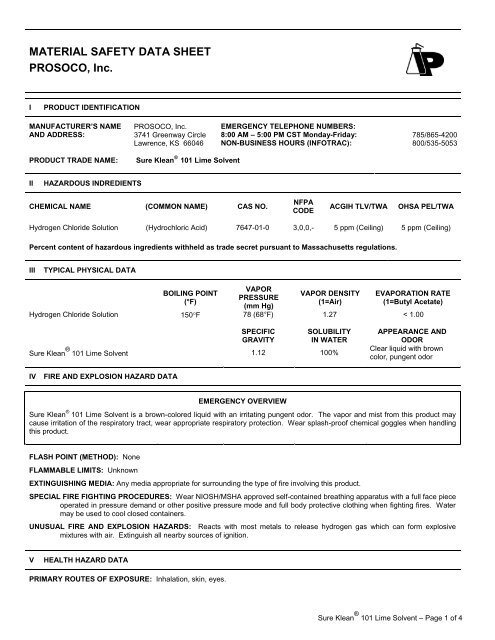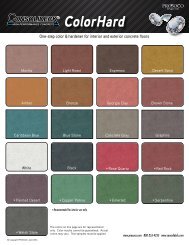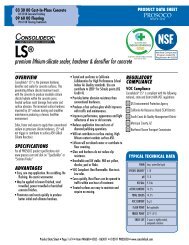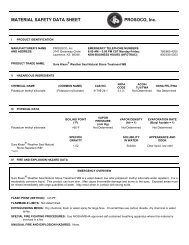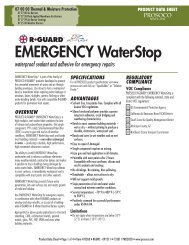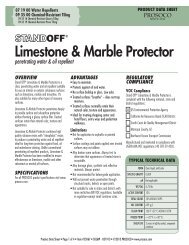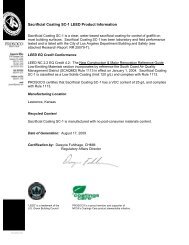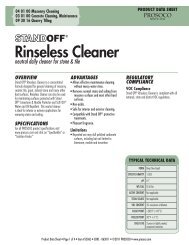SK 101 Lime Solvent MSDS - PROSOCO, Inc.
SK 101 Lime Solvent MSDS - PROSOCO, Inc.
SK 101 Lime Solvent MSDS - PROSOCO, Inc.
Create successful ePaper yourself
Turn your PDF publications into a flip-book with our unique Google optimized e-Paper software.
MATERIAL SAFETY DATA SHEET<strong>PROSOCO</strong>, <strong>Inc</strong>.IPRODUCT IDENTIFICATIONMANUFACTURER’S NAMEAND ADDRESS:<strong>PROSOCO</strong>, <strong>Inc</strong>.3741 Greenway CircleLawrence, KS 66046EMERGENCY TELEPHONE NUMBERS:8:00 AM – 5:00 PM CST Monday-Friday:NON-BUSINESS HOURS (INFOTRAC):785/865-4200800/535-5053PRODUCT TRADE NAME:Sure Klean ® <strong>101</strong> <strong>Lime</strong> <strong>Solvent</strong>IIHAZARDOUS INDREDIENTSCHEMICAL NAME (COMMON NAME) CAS NO.NFPACODEACGIH TLV/TWAOHSA PEL/TWAHydrogen Chloride Solution (Hydrochloric Acid) 7647-01-0 3,0,0,- 5 ppm (Ceiling) 5 ppm (Ceiling)Percent content of hazardous ingredients withheld as trade secret pursuant to Massachusetts regulations.IIITYPICAL PHYSICAL DATABOILING POINT(°F)VAPORPRESSURE(mm Hg)VAPOR DENSITY(1=Air)EVAPORATION RATE(1=Butyl Acetate)Hydrogen Chloride Solution 150F 78 (68°F) 1.27 < 1.00SPECIFICGRAVITYSOLUBILITYIN WATERSure Klean ® <strong>101</strong> <strong>Lime</strong> <strong>Solvent</strong> 1.12 100%APPEARANCE ANDODORClear liquid with browncolor, pungent odorIVFIRE AND EXPLOSION HAZARD DATAEMERGENCY OVERVIEWSure Klean ® <strong>101</strong> <strong>Lime</strong> <strong>Solvent</strong> is a brown-colored liquid with an irritating pungent odor. The vapor and mist from this product maycause irritation of the respiratory tract, wear appropriate respiratory protection. Wear splash-proof chemical goggles when handlingthis product.FLASH POINT (METHOD): NoneFLAMMABLE LIMITS: UnknownEXTINGUISHING MEDIA: Any media appropriate for surrounding the type of fire involving this product.SPECIAL FIRE FIGHTING PROCEDURES: Wear NIOSH/MSHA approved self-contained breathing apparatus with a full face pieceoperated in pressure demand or other positive pressure mode and full body protective clothing when fighting fires. Watermay be used to cool closed containers.UNUSUAL FIRE AND EXPLOSION HAZARDS: Reacts with most metals to release hydrogen gas which can form explosivemixtures with air. Extinguish all nearby sources of ignition.VHEALTH HAZARD DATAPRIMARY ROUTES OF EXPOSURE: Inhalation, skin, eyes.Sure Klean ® <strong>101</strong> <strong>Lime</strong> <strong>Solvent</strong> – Page 1 of 4
CARCINOGEN INFORMATION: Not listed (OSHA, IARC, NTP). No standard carcinogenicity studies for hydrogen chloride wereidentified. Two studies on rats were conducted to determine if hydrogen chloride increased the formation of nasal tumorsor increased the carcinogenic potential of formaldehyde. In both studies the rats were exposed to 10-ppm hydrogenchloride, 6 hours per day, 5 days per week. One study lasted 84 weeks while the other lasted the animals’ lifetime.Hydrogen chloride did not cause an increase in nasal tumors and did not increase the carcinogenicity of formaldehyde.MEDICAL CONDITIONS AGGRAVATED BY OVEREXPOSURE: Asthma, bronchitis, emphysema, and other lung conditions; andchronic nose, sinus, or throat conditions. Exposures of 100 ppm for six hours a day for 50 days caused only slight unrestand irritation to the eyes and nose of rabbits, guinea pigs and pigeons. The hemoglobin content of the blood was alsoslightly diminished. Monkeys receiving 20 exposures of 33 ppm for six hours did not display any adverse effects. Higherexposures (unspecified) have caused weight loss which paralleled the severity of exposure. Baboons exposed to 500,5000 or 10,000 ppm for 15 minutes did not have significant alterations in any pulmonary function parameters 3 days or 3months after exposure. In humans long term overexposure has been associated with erosion of the teeth.EFFECTS OF OVER EXPOSURE: Causes severe damage to eyes and even blindness very rapidly. Causes burns, possible deepulceration to skin. Breathing of mist or dust can cause damage to nasal and respiratory passages. Swallowing results insevere damage to mucous membranes and deep tissue; can result in death on penetration to vital areas.EYE CONTACT: Liquid or concentrated vapors can cause eye irritation, severe burns and permanent damage including blindnesseven after a short exposure to small amounts.<strong>SK</strong>IN CONTACT: Liquid or concentrated vapors can rapidly cause burning of skin. Repeated or prolonged contact with dilutesolutions and concentrated vapors can cause irritation and dermatitis.INHALATION: Hydrogen chloride gas, mist, and vapor can cause irritation of respiratory tract, with burning, choking, coughing,headaches, and rapid heartbeat. 35 ppm can cause irritation of the throat and 50-100 ppm is nearly unbearable for onehour. Inflammation, destruction of nasal passages and breathing difficulties can occur with high concentrations and maybe delayed in onset. Inhalation of sufficiently high concentrations may result in laryngeal spasms, laryngeal edema orrapidly developing pulmonary edema. Mists may also cause bleeding of the nose and gums, and ulceration of the nasal ororal mucosa. 1,000-2,000 ppm can be fatal.INGESTION: Unlikely route of exposure. Can cause severe burns of mouth, esophagus, and stomach. Nausea, pain, and vomitingmay occur. Depending on the amount swallowed, holes may develop in the intestinal tract, kidney inflammation, shockand death can occur.EMERGENCY AND FIRST AID PROCEDURES:EYE CONTACT: Rinse eyes with large quantities of water for at least 15 minutes, holding eyelids apart to ensure flushing of theentire eye surface. Get medical attention immediately.<strong>SK</strong>IN CONTACT: Remove contaminated clothing and flush exposed area with large quantities of water for at least 15 minutes.Launder contaminated clothing before reuse. Discard contaminated shoes. Get immediate medical attention.INHALATION: Remove person to fresh air. If breathing stops, administer artificial respiration, preferably mouth-to-mouth. Ifbreathing is difficult, give oxygen. Get medical attention immediately.INGESTION: If conscious, give large quantities of water or milk. Do not induce vomiting. Get medical attention immediately. Donot give anything by mouth to an unconscious or convulsing person.VI REACTIVITY DATASTABILITY: StableCONDITIONS TO AVOID: Contact with strong bases (alkali), can cause violent reaction generating large amounts of heat.INCOMPATIBILITY (MATERIALS TO AVOID): Metals, oxidizing agents, nitric acid, chlorates, sulfides, and cyanides. Contact withsulfides releases poisonous flammable hydrogen sulfide. Mercuric sulfate, perchloric acid, carbides of calcium, cesium,rubidium, acetylides of cesium and rubidium, phosphides of calcium and uranium, and lithium silicide.Hydrogen Chloride can react with cyanide, forming lethal concentrations of hydrocyanic acid. Do not enter confinedspaces such as tanks or pits without proper entry procedures as required by 29 CFR 1910.146.HAZARDOUS COMBUSTION OR DECOMPOSITION PRODUCTS: Hydrogen gas when contacting metals, hydrogen chloride,carbon monoxide and carbon dioxide. Hydrogen gas generation has the highest potential for harm in confined or poorlyventilated areas where concentrations can approach flammable or explosive concentrations.Sure Klean ® <strong>101</strong> <strong>Lime</strong> <strong>Solvent</strong> – Page 2 of 4
VII SPILL OR LEAK PROCEDURESSPILL, LEAK, WASTE DISPOSAL PROCEDURES: Evacuate immediate area where concentrated fumes are present. Cleanuppersonnel must wear proper protective equipment. Provide adequate ventilation. Completely contain spilled material withdikes, etc., and prevent runoff into ground and surface waters or into sewers.Dilution with water will decrease the fumes generated from spilled product. Spills and leaks should be neutralized bypouring dry soda ash or lime over the affected area. Concentrated product should be diluted with water before addingneutralizing agents to keep splattering and fumes to a minimum. Approximately 2.5 pounds of lime are required toneutralize one gallon of this product. Allow powdered material to remain on spill for five to ten minutes and flushthoroughly with water. Neutralized material, both liquid and solid, should be recovered for proper disposal.WASTE DISPOSAL METHODS: Recovered solids or liquids may be disposed of in a permitted waste management facility.Neutralized materials may be discharged to a sanitary sewer with approval of the receiving treatment plant. Typical pHrange of 6-10 is generally considered appropriate for discharge. Consult federal, state, and/or local authorities forapproved procedure. For additional information regarding handling and disposal of rinse-water, please review TechnicalBulletin 200-CW “Controlled Handling of Cleaning Wastewater”. Empty containers must be triple rinsed before disposal ina permitted sanitary landfill. Check local restrictions.VIII SPECIAL PROTECTION INFORMATIONRESPIRATORY PROTECTION: For vapor or mist concentrations which exceed or are likely to exceed 5 ppm Threshold Limit Value(TLV), wear a NIOSH/MSHA approved half-mask respirator with acid gas cartridges. NIOSH/MSHA approvedself-contained breathing apparatus (SCBA) or pressure demand supplied air respirator with full face piece should be wornwhen concentrations exceed 50 ppm. A SCBA is recommended by NIOSH during leaks and/or emergencies. Follow allapplicable respirator use standards and regulations.VENTILATION: Provide sufficient general and/or local exhaust ventilation to maintain exposure below the TLV.PROTECTIVE CLOTHING: Wear splash resistant neoprene or PVC rain suit.PROTECTIVE GLOVES: Nitrile rubber type, neoprene or PVC with acceptable acid resistance.EYE PROTECTION: Chemical splash goggles and/or full face shield (8 inch minimum) in compliance with OSHA regulations. Donot wear contact lenses because they may contribute to the severity of an eye injury.OTHER PROTECTIVE EQUIPMENT: Acid-resistant rubber boots, headgear. Eyewash and safety shower.IX SPECIAL PRECAUTIONSWORK PRACTICES: Proper work practices and planning should be utilized to avoid contact with workers, passersby, and nonmasonrysurfaces. Brush on or apply at the lowest practical pressure. Do not atomize during application. Applicationequipment, scaffolding, swing stages and support systems must be constructed of acid resistant materials. Use only wellmaintained staging and scaffolding that is equipped with steel cable. This product will attack nylon, cotton and hemproping. Use polypropylene ropes and safety lines. Dilution and application equipment should be of polypropylene orHDPE construction. Beware of wind drift. Wind-drift hazards may be diminished by pre-rinsing with low pressure waterbefore pressure washing. Divert pedestrian traffic around work areas. See the Product Data sheet and label for specificprecautions to be taken during use. Smoking, eating and drinking should be discouraged during the use of this product.Wash hands after handling or use.This product is only to be used as supplied and specified. Do not alter, mix with chlorine-type bleaches or otherchemicals, or dilute product except as specified on the label and Product Data sheet.PRECAUTIONS TO BE TAKEN IN HANDLING AND STORAGE: Use proper safety equipment (see section VIII) when handling.Store in a cool, well-ventilated area. Separate from oxidizing agents, nitric acid, alkalis, chlorates, sulfides, etc. (seesection VI). Do not remove product label. Material diluted for application must be properly labeled and stored inacid-resistant containers with rubber-lined steel, polypropylene or polyethylene construction..Addition of acidic cleaner to water releases heat, which can result in violent boiling and spattering. Always add cleaner towater slowly and in small amounts. Never use hot water. Never add water to acidic cleaners.Containers of this material may be hazardous when emptied, since emptied containers retain product residues (vapor,liquid, and/or solid). All hazard precautions given in this data sheet must be observed.OTHER PRECAUTIONS: Do not get in eyes, on skin or on clothing. Can cause severe injury or blindness. Avoid breathing mist orvapor. Provide ventilation sufficient to limit employee exposure below OSHA permissible limit. Do not take internally.Wash thoroughly after handling.Sure Klean ® <strong>101</strong> <strong>Lime</strong> <strong>Solvent</strong> – Page 3 of 4
X REGULATORY INFORMATIONSHIPPING: This product carries the shipping description “UN3264, Corrosive liquid, acidic, inorganic, n.o.s. (Hydrochloricacid), 8, II” for shipping by ground, air and ocean transport. The product meets applicable DOT and UN standards whenshipped in the original, unopened factory packaging, although container size may be limited for air transport. Some parcelshipping companies may limit container sizes.NATIONAL MOTOR FREIGHT CLASSIFICATION: 44157 Sub 3 Rate Class: 85SARA 313 REPORTABLE:CHEMICAL NAME CAS UPPERBOUND CONCENTRATION % BY WEIGHTHydrogen Chloride 7647-01-0 30 %CALIFORNIA PROPOSITION 65: This product contains no chemicals listed under California’s Proposition 65.XI OTHER<strong>MSDS</strong> Status: Date of Revision: May 1, 2012For Product Manufactured After: February, 2005Changes: Regulatory Review – no changes but document date brought currentItem #: 10010Approved By: Product Stewardship CommitteeDISCLAIMER:The information contained on the Material Safety Data Sheet has been compiled from data considered accurate. This datais believed to be reliable, but it must be pointed out that values for certain properties are known to vary from source tosource. <strong>PROSOCO</strong>, <strong>Inc</strong>. expressly disclaims any warranty express or implied as well as any liability for any injury or lossarising from the use of this information or the materials described. This data is not to be construed as absolutely completesince additional data may be desirable when particular conditions or circumstances exist. It is the responsibility of the userto determine the best precautions necessary for the safe handling and use of this product for his unique application. Thisdata relates only to the specific material designated and is not to be used in combination with any other material. Manyfederal and state regulations pertain directly or indirectly to the product's end use and disposal of containers and unusedmaterial. It is the purchaser's responsibility to familiarize himself with all applicable regulations.DATE OF PREPARATION: May 1, 2012Sure Klean ® <strong>101</strong> <strong>Lime</strong> <strong>Solvent</strong> – Page 4 of 4


